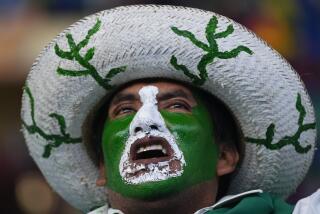FINANCE : Life Returning to a Moribund Peru Economy : Production surges and inflation abates as once-sickly nation shows signs of a vigorous recovery.
- Share via
LIMA, Peru — For years, this country was the sick man of South American economies, but not now. Peru is getting better.
National production, which had fallen by 20% in the previous five years, is surging at an estimated 7% this year. Inflation, which blazed at more than 7,000% in 1990, is under control.
A cruel and costly guerrilla war appears to be winding down after 13 years; businessmen are applauding the government’s market policies; investment is starting to flow.
Analysts say problems remain but that prospects are bright for a vigorous and lasting economic recovery. “The patient Peru’s fever has gone down,” said Jose Carlos Luque, chairman of the Lima Stock Exchange. “Now he has a low, controlled fever that isn’t worrisome.”
High hopes for a healthy economy are reflected in Lima’s small stock market, which has been rising by more than 100% annually since 1991--the first full year of President Alberto Fujimori’s administration.
Fujimori has backed tough austerity measures and strict monetary discipline that have helped bring inflation down from 7,650% in 1990 to an expected 40% this year.
“If this policy continues, in eight more months inflation will be finished in Peru,” said Jorge Gonzalez Isquierdo, dean of the Economics Department at Lima’s Universidad del Pacifico.
At first, the belt-tightening stifled economic growth. Reforms, carried out mostly by former Economy Minister Carlos Bolona, cut government spending, ended subsidies, restricted the money supply and reduced protective import duties. “All that was done, and now it is starting to bear fruit,” said Bolona, who resigned in January because of frayed relations with Fujimori.
This year’s surge in economic growth follows a 2.5% contraction in 1992. Even with 7% expansion this year, the economy will still be smaller than in the 1980s.
But Bolona and other analysts emphasized that the growth is solidly based on efficient production gains, especially in the fishing, mining, electrical and construction industries.
The government has forecast growth of 4.5% for next year, but banker Ivan Carrillo predicts “not less than 7%” for 1994.
“The fuel for growth should be the privatization process,” said Carrillo, a Citibank vice president for Peru. The government began privatizing state enterprises last year, but critics have complained that progress has been slow.
Fujimori said in an interview that delays have been caused by the process of “cleaning up” government corporations by trimming payrolls, reorganizing and paying off debts. As a result, he said, public enterprises “are being sold at prices much higher than expected.”
Foreign investors have brought an estimated $800 million to Peru this year. And Peruvian “flight capital,” private funds invested abroad during bad times here, is coming back home. Some economists estimate that from a total of $6 billion abroad, $2 billion has returned so far, much of it going into productive investments such as factory modernization.
Not all is well, however. Peru is still having trouble paying its $22-billion foreign debt, partly because export revenues have remained flat. International prices for some of Peru’s main exports, including minerals and fish meal, are down this year. But analysts say export industries need more investment and greater efficiency to increase income.
Another problem is the government’s difficulty in raising tax revenues to pay for long-neglected social needs such as health, education and housing. Critics call for a general reform of the tax structure and say too many well-off Peruvians don’t pay their fair share.
Confidence in Peru’s political stability is also a potential economic issue. Fujimori violated the 1979 constitution to shut the Congress in a military-backed “self-coup” April 5, 1992. Later that year, he held elections for a new, unicameral Congress.
The Congress, dominated by Fujimori supporters, rewrote the constitution. The new charter was expected to be approved by a wide majority in a popular referendum Oct. 31 but passed with only about 52% of the valid votes.
Peru’s Upbeat Economy
Peru had long been considered one of the sicklier economies of South America. But the policies of President Alberto Fujimori, right, appear to be reversing this trend, as these key indicators show:
Change in Gross Domestic Product
1989: -11.6%
1990: -4.9%
1991: 2.8%
1992: -2.5%
1993: 7%*
* Projected
Sources: Include National Statistics Institute, Central Reserve Bank, Apoyo S.A.
More to Read
Sign up for Essential California
The most important California stories and recommendations in your inbox every morning.
You may occasionally receive promotional content from the Los Angeles Times.










